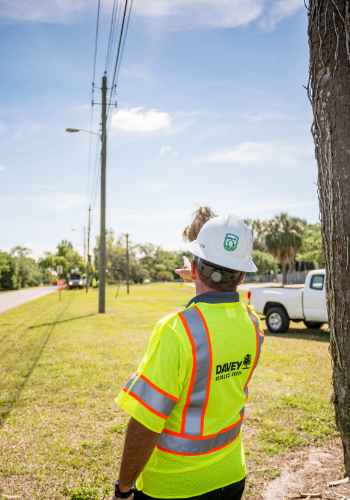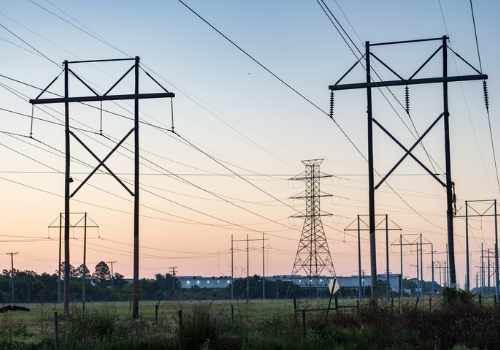Trees are a leading cause of electric outages in the United States with an annual economic impact exceeding $100 billion. A small percentage of those outages are caused by trees growing into contact with distribution lines. The vast majority occur when a tree or limb falls onto the lines. Most of those trees are growing outside the utility right-of-way. Wind speed and tree failure are directly related so that storm conditions, tree failure and resulting outages often occur together.
Removing vegetation from utility corridors seems straightforward, but it isn’t. The complexity starts with regulations, says Jack McCabe, vice president and general manager of utility management solutions, Davey Resource Group.
There are both Federal and State regulations. The delineator is generally that transmission lines of 200 kilovolts or more are overseen by the Federal government while lower voltage transmission and distribution lines are regulated by the state in which they are located.
Then there’s the North American Electric Reliability Corporation (NERC), which develops and enforces reliability standards. NERC is the Electric Reliability Organization (ERO) for North America and answers to the Federal Energy Regulatory Commission (FERC) in the U.S. and governmental authorities in Canada. NERC’s reason for being is to ensure uptime for the electric grid that serves hundreds of millions of persons in its coverage zone.
Among the NERC standards are those for maintaining clearance between trees and power lines. This is to prevent trees from growing into lines, of course, but also to minimize the risk of arc-over, where an electrical discharge goes from the powerline to a tree. Required clearances are spelled out in a document known as FAC-003-x (a series of revisions exists). Fines for utility companies that fail to maintain this clearance can be up to $1 million per day.
Clearly the government is serious about this tree-trimming business, and for good reason. That good reason is known as “cascading:” a tree damages a line in rural Vermont and within minutes the entire Northeast is without power, possibly for days.
 Best Practices and New Technologies for Vegetation Management
Best Practices and New Technologies for Vegetation Management
Utilities typically maintain some type of tree-caused outage investigation and analysis program. Utility foresters know that all trees are not the same, and therefore it is only a handful of species, and sometimes only one, that causes the majority of problems.
Those species that cause most of the outages also typically have a specific failure type, such as limb failure, trunk failure or uprooting. We also know that outages are located in specific areas based on forest distribution and other geographic factors and do not occur uniformly across the system.
Using this information, along with customer density and the design of the system, utilities can focus reliability efforts in places where they can improve service to the largest number of customers.
New and emerging technologies offer several ways for utilities to improve the effectiveness of their vegetation management programs. Remote sensing technology like LiDAR and satellite/aerial imagery provide useful information on the extent, location and maintenance requirements of vegetation throughout the utility's footprint. Each technology offers different advantages and costs and there is typically no one perfect approach.
“Data science is proving to be very effective in leveraging experience in order to predict the future,” says McCabe. “With quality data on historical outages, we are finding that we can predict where tree caused outages will occur based on wind and weather. This can help utilities both target maintenance dollars more effectively and prepare for storm events for faster restoration. We also use mobile computing to aid in dispatching and routing crews to respond more quickly and efficiently.”
 Integrated Vegetation Management Approaches
Integrated Vegetation Management Approaches
Equipment has evolved far beyond the bucket truck and chainsaw approach of years past. Such setups still see heavy use, but smaller trucks are in vogue to provide access to a greater number of lines and to reduce the need for CDL-qualified tree workers. Radial saws on articulating arms get mounted to all types of equipment, from skid steer loader to hydraulic excavators. Similar setups can be used from helicopters.
Herbicides are effective. Public acceptance of chemical treatment varies from one area to another.
“A growing trend is integrated vegetation management,” says McCabe, “which is an outgrowth of integrated pest management.” Where the traditional approach was to cut everything and then come back in a few years and do it again, this integrated approach starts with objectives and then considers all the possible means of reaching those objectives given the characteristics of the ecosystem in the target area.
An emerging technique for integrated management and for vegetation management in general is the use of shrubby plants in the corridor. These compete with and block the establishment of larger plants, including trees, while remaining too low to present a hazard. Periodic spot application of herbicides using a backpack sprayer or UTV-mounted sprayer can control the few trees that do get started. “The goal is to continuously maintain the corridor as an early successional ecosystem.” The integrated approach takes time and may have higher costs at the outset, but the lowest cost in the long run.
McCabe offers three key points to keep in mind:
- It’s a fun time to be in this business due to advances in technology, equipment and safety, and just the general maturing of the industry.
- Demand for cost-effectiveness continues to grow, driven in part by renewables. This compels the utilities to drive contractors for cost savings.
- Intangibles, especially worker safety and environmental stewardship, are big components of this industry.
Davey Resource Group is a subsidiary of The Davey Tree Expert Company, provider of tree services, grounds maintenance and environmental solutions for residential, utility, commercial and environmental partners across North America. Jack McCabe joined Davey in 1999 as a supervising consulting utility forester. He holds a B.S. in environmental studies from the University of California, Santa Cruz.
“I answered an ad for a forester and was surprised to find out it was utility vegetation management. Perhaps more surprising was that knowledge I acquired in all of my courses, from environmental studies to policy making to forestry, was required to do the job well.”
Join thousands of industry peers who receive utility construction industry news and trends each week. Subscribe to The Utility Expo Newsletter.












